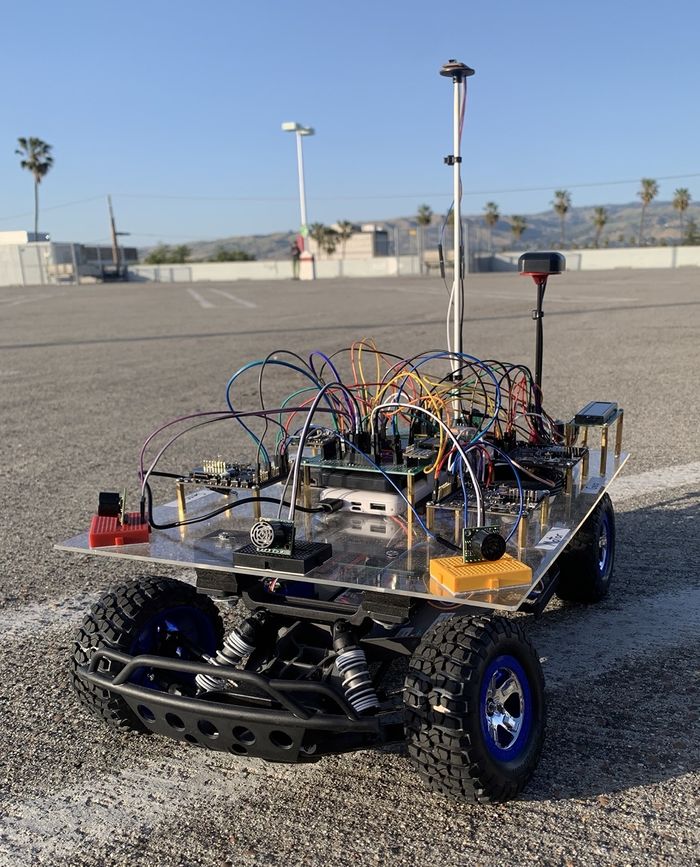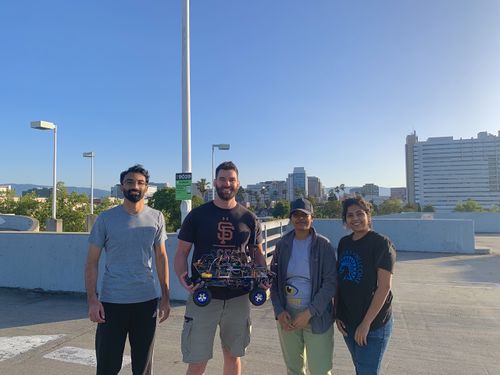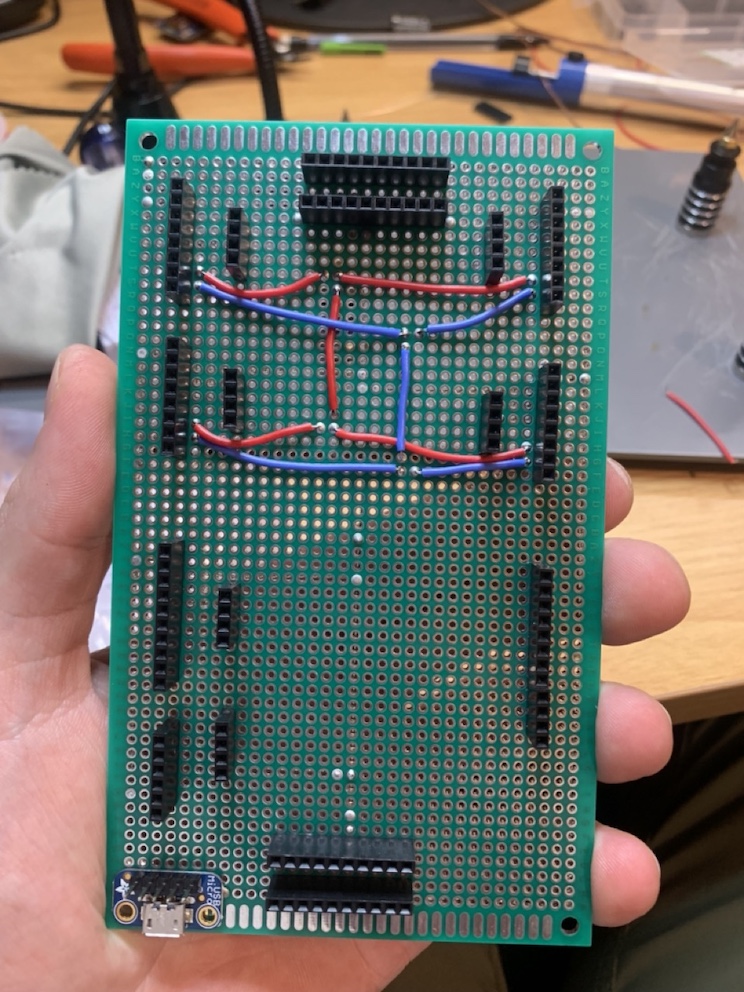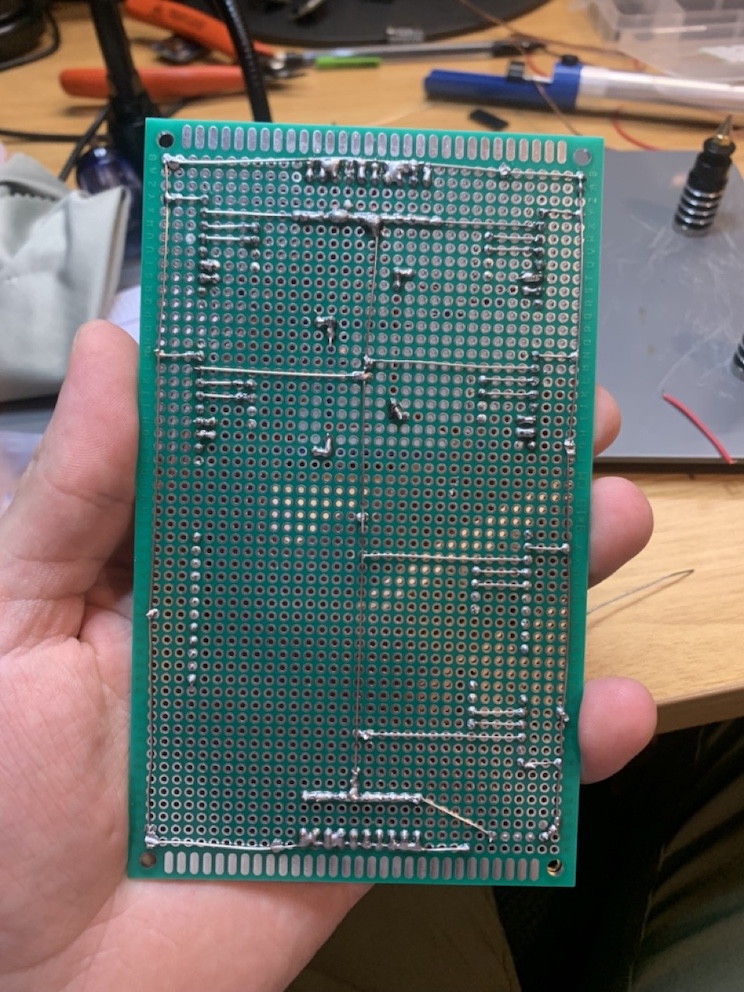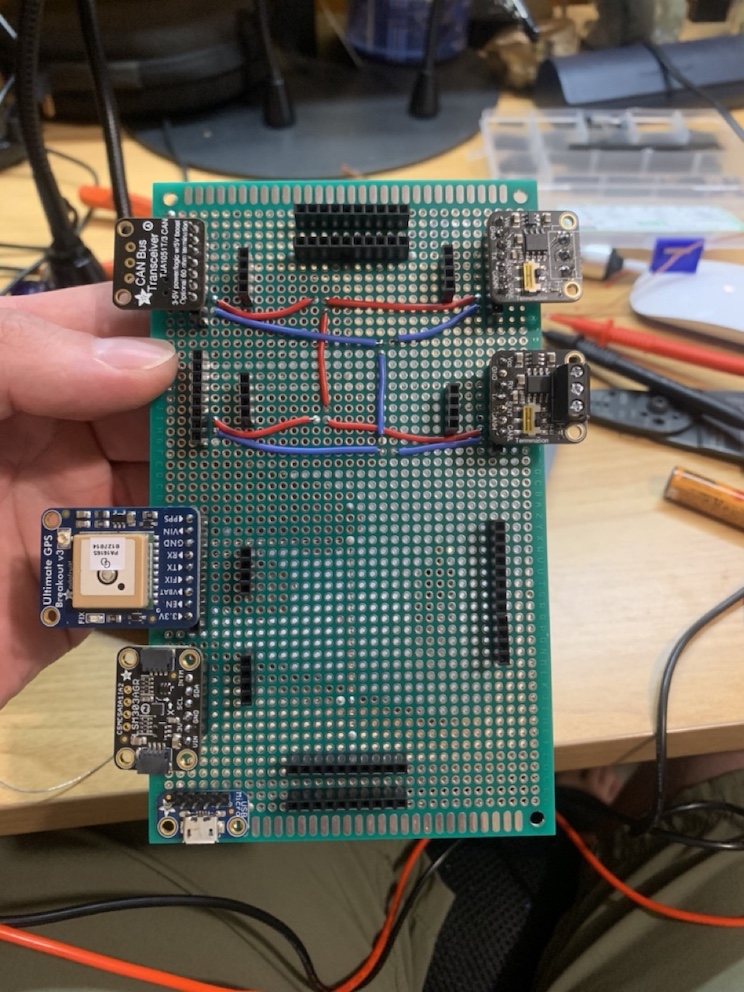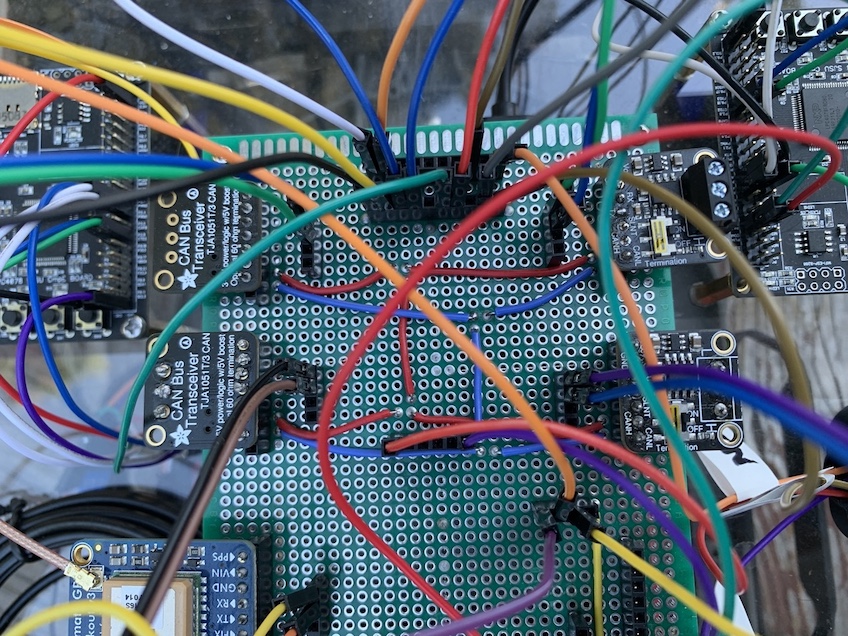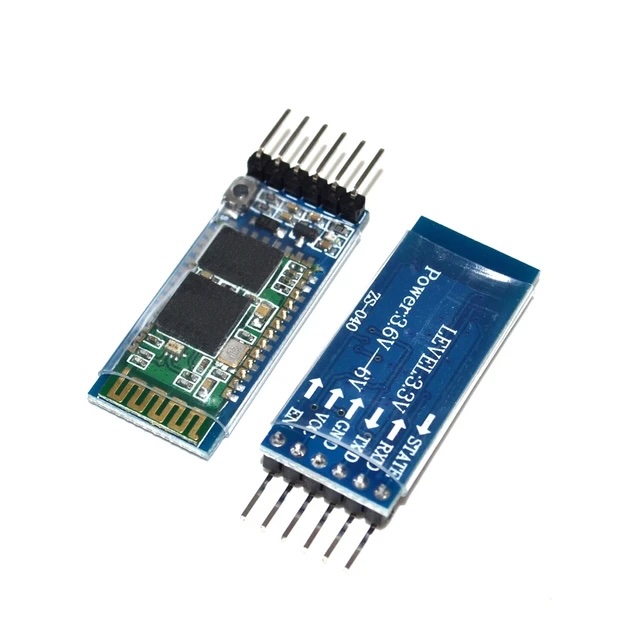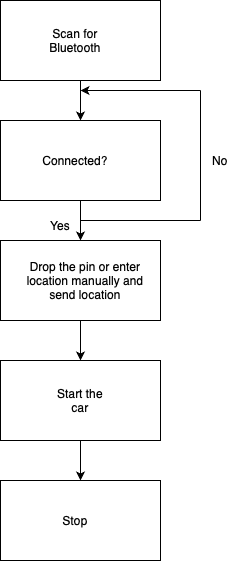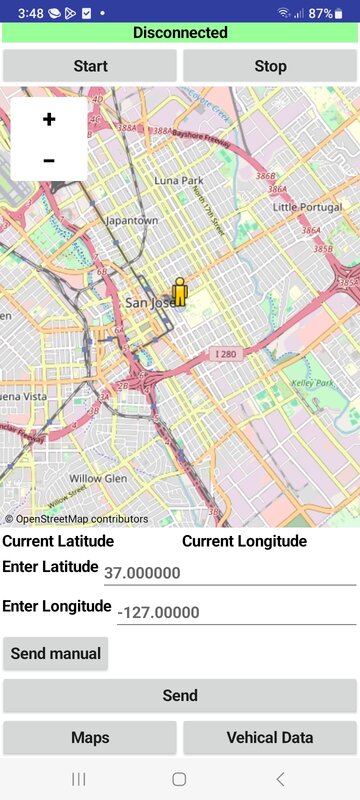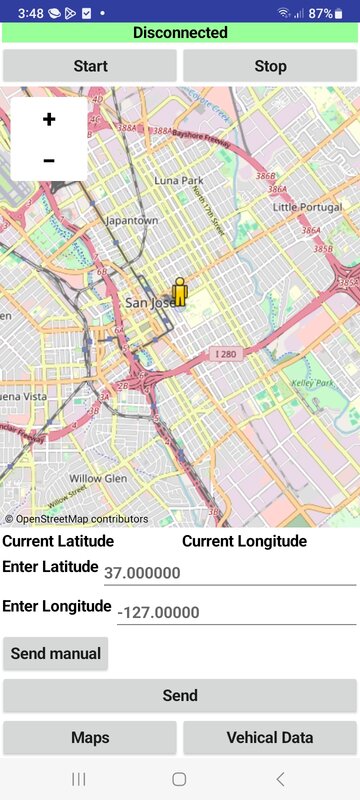S24: Team Zero
Contents
Project Title
TEAM ZERO
Abstract
Team Zero's Self driving RC car, as the name states, is an autonomous vehicle designed to navigate to a given specified destination successfully, avoiding obstacles along its way. The car's infrastructure is built upon four key components: the Driver, Sensor-Bridge, Geo, and Motor nodes, which communicate internally via a CAN Bus and with the user via a mobile app. The vehicle continuously senses and processes all the information from these nodes to make decisions to ensure it stays on course and reaches its destination. It is built on a hobby-grade RC car chassis, modified with the necessary components and adjustments to fulfill its primary objectives of autonomous navigation and obstacle avoidance.
Introduction
The project was divided into N modules:
- Geographical Controller and LCD
- Motor Controller
- Sensor-Bridge Controller
- Driver Controller
- Mobile Application
Team Members & Responsibilities
]Gitlab Project Link - [1]
Cody Ourique [2]
- Geo controller
- Compass,GPS and LCD interfacing
- Hardware design, development and mounting
- LCD modules
- Unit Testing
Anusha Arunnandi [3]
- Sensor-Bridge controller
- Ultrasonic range finder and bluetooth interfacing
- Web application
- Unit Testing
Chaitanya Battula [4]
- Driver controller
- Motor controller
- RPM sensor, ESC, and servo motor interfacing
- Unit Testing
Rohit Duvvuru [5]
- Unit Testing
Schedule
| Week# | Start Date | End Date | Task | Status |
|---|---|---|---|---|
| 1 | 03/03/2024 | 03/09/2024 |
|
Completed |
| 2 | 03/10/2024 | 03/16/2024 |
|
Incomplete |
| 3 | 03/17/2024 | 03/23/2024 |
|
Incomplete |
| 4 | 03/24/2024 | 03/30/2024 |
|
Incomplete |
| 5 | 03/31/2024 | 04/06/2024 |
|
Incomplete |
| 6 | 04/07/2024 | 04/13/2024 |
|
Incomplete |
| 7 | 04/14/2024 | 04/20/2024 |
|
Incomplete |
| 8 | 04/21/2024 | 04/27/2024 |
|
Incomplete |
| 9 | 04/28/2024 | 05/04/2024 |
|
Incomplete |
| 10 | 05/05/2024 | 05/11/2024 |
|
Incomplete |
| 11 | 05/12/2024 | 05/18/2024 |
|
Incomplete |
| 12 | 05/19/2024 | 05/25/2024 |
|
Incomplete |
Parts List & Cost
| Item# | Part Desciption | Vendor | Qty | Cost |
|---|---|---|---|---|
| 1 | RC car | Traxxas [6] | 1 | $239.95 |
| 2 | RPM sensor | Traxxas [7] | 1 | $12.00 |
| 3 | GPS Breakout Board | Adafruit [8] | 1 | $54.95 |
| 4 | PCB prototype circuit board | A1 Cables N PCBs [9] | 1 | $8.57 |
| 5 | Plexiglass | Lesnlok [10] | 1 | $9.98 |
| 6 | Wireless bluetooth RF transceiver | HiLetgo [11] | 1 | $9.95 |
| 7 | Compass | Adafruit [12] | 1 | $5.95 |
| 8 | Ultrasonic range finder | Adafruit [13] | 4 | $114.00 |
| 8 | Potentiometer | Amazon [14] | 1 | $9.99 |
| 8 | 2 Pack 15000mAh power bank | Amazon [15] | 1 | $19.99 |
| 8 | GPS Antenna Mount | Honbay [16] | 2 | $7.29 |
| 8 | I2C Qwiic Cable Kit | Amazon [17] | 1 | $9.99 |
| 8 | Black Foam Padding | Amazon [18] | 1 | $11.99 |
| 8 | Traxxas 6537 Wire Retainers | Amazon [19] | 1 | $6.95 |
| 8 | USB Micro-B Breakout Board | Adafruit [20] | 1 | $4.88 |
| 8 | 24 awg Wire Solid Core | Amazon [21] | 1 | $14.99 |
| 8 | ELEGOO 6PCS 170 tie-Points Mini Breadboard | Amazon [22] | 1 | $6.98 |
| 8 | GPS Antenna | Amazon [23] | 1 | $10.99 |
| 8 | Standoffs | Amazon [24] | 1 | $22.96 |
| 8 | Breadboard Wires | Amazon [25] | 1 | $5.97 |
| 8 | 3/16 inch fiberglass rod | TAP plastics | 1 | $5.11 |
Prototype Circuit Board
This prototype circuit board was carefully designed so that it could power all the microcontrollers, compass module, GPS module, bluetooth module, ultrasonic sensors and the LCD. In addition, the board has 4 slots for CAN tranceivers and an integrated CAN bus line. The board has a common ground line for all connected devices and has a total of 20 available sockets. Also, the board has 3.3V power and has 20 open sockets. Additionally, the board has 5V power with 4 available sockets delivered via micro USB.
CAN Communication
<Talk about your message IDs or communication strategy, such as periodic transmission, MIA management etc.> The microcontrollers communicate using the CAN bus. Each controller is sending or receiving CAN messages through periodic callback functions.
Geological Controller CAN Messages:
- GEO_READINGS
- GEO_DATA_TO_DRIVER_AND_BRIDGE
- GEO_DEBUG_MESSAGE
Sensor_Bridge Controller CAN Messages:
- SENSOR_ULTRA_SONIC
- SENSOR_BATTERY
- BRIDGE_DATA_TRANSFER
Motor Controller CAN Messages:
- MOTOR_READINGS
Driver Controller CAN Messages:
- DRIVER_HEARTBEAT
- MOTOR_CMD
Hardware Design
DBC File
VERSION "" NS_ : BA_ BA_DEF_ BA_DEF_DEF_ BA_DEF_DEF_REL_ BA_DEF_REL_ BA_DEF_SGTYPE_ BA_REL_ BA_SGTYPE_ BO_TX_BU_ BU_BO_REL_ BU_EV_REL_ BU_SG_REL_ CAT_ CAT_DEF_ CM_ ENVVAR_DATA_ EV_DATA_ FILTER NS_DESC_ SGTYPE_ SGTYPE_VAL_ SG_MUL_VAL_ SIGTYPE_VALTYPE_ SIG_GROUP_ SIG_TYPE_REF_ SIG_VALTYPE_ VAL_ VAL_TABLE_ BS_: BU_: DBG DRIVER MOTOR SENSOR_BRIDGE GEO BO_ 100 DRIVER_HEARTBEAT: 1 DRIVER SG_ DRIVER_HEARTBEAT_cmd : 0|8@1+ (1,0) [0|0] "" SENSOR_BRIDGE,MOTOR BO_ 101 MOTOR_CMD: 1 DRIVER SG_ MOTOR_CMD_steer : 0|4@1- (1,0) [-5|5] "steering direction" MOTOR SG_ MOTOR_CMD_drive : 4|4@1+ (0.1,-5) [-5|5] "kph" MOTOR BO_ 102 MOTOR_READINGS: 4 MOTOR SG_ MOTOR_READINGS_steer_degrees : 0|4@1- (1,0) [-5|5] "steer direction" DRIVER SG_ MOTOR_READINGS_speed : 4|4@1+ (0.1,-5) [-5|5] "kph" DRIVER BO_ 200 SENSOR_ULTRA_SONIC: 8 SENSOR_BRIDGE SG_ SENSOR_ULTRA_SONIC_left : 0|10@1+ (1,0) [0|500] "cm" DRIVER SG_ SENSOR_ULTRA_SONIC_right : 10|10@1+ (1,0) [0|500] "cm" DRIVER SG_ SENSOR_ULTRA_SONIC_middle : 20|10@1+ (1,0) [0|500] "cm" DRIVER SG_ SENSOR_ULTRA_SONIC_back : 30|10@1+ (1,0) [0|500] "cm" DRIVER BO_ 202 SENSOR_BATTERY: 1 SENSOR_BRIDGE SG_ SENSOR_BATTERY_voltage : 0|8@1+ (1,0) [0|0] "V" DRIVER BO_ 300 BRIDGE_DATA_TRANSFER: 8 SENSOR_BRIDGE SG_ GPS_DESTINATION_send_latitude : 0|32@1+ (0.000001,0) [0|0] "Degrees" GEO SG_ GPS_DESTINATION_send_longitude : 32|32@1+ (0.000001,0) [0|0] "Degrees" GEO BO_ 301 GEO_READINGS: 8 GEO SG_ GEO_READINGS_COMPASS_HEADING : 0|12@1+ (1,0) [0|359] "Degrees" DRIVER, SENSOR_BRIDGE SG_ GEO_READINGS_COMPASS_BEARING : 12|12@1+ (1,0) [0|359] "Degrees" DRIVER, SENSOR_BRIDGE SG_ GEO_READINGS_DISTANCE_TO_DESTINATION : 24|24@1+ (1,0) [0|0] "Meters" DRIVER, SENSOR_BRIDGE BO_ 302 GEO_DATA_TO_DRIVER_AND_BRIDGE: 8 GEO SG_ GEO_DATA_TO_DRIVER_AND_BRIDGE_latitude : 0|32@1+ (0.000001,0) [0|0] "Degrees" DRIVER, SENSOR_BRIDGE SG_ GEO_DATA_TO_DRIVER_AND_BRIDGE_longitude : 32|32@1+ (0.000001,0) [0|0] "Degrees" DRIVER, SENSOR_BRIDGE BO_ 304 GEO_DEBUG_MESSAGE: 2 GEO SG_ GEO_DEBUG_MESSAGE_LOCK : 0|8@1+ (1,0) [0|0] "Boolean" DRIVER SG_ GEO_DEBUG_MESSAGE_LOCK_TIME : 8|8@1+ (0.1,0) [0|0] "Seconds" DRIVER CM_ BU_ GEO "The gps contoller"; CM_ BU_ SENSOR_BRIDGE "The bridge controller"; CM_ BU_ DRIVER "The driver controller driving the car"; CM_ BU_ MOTOR "The motor controller of the car"; CM_ BO_ 100 "Sync message used to synchronize the controllers"; CM_ SG_ 100 DRIVER_HEARTBEAT_cmd "Heartbeat command from the driver"; BA_DEF_ "BusType" STRING ; BA_DEF_ BO_ "GenMsgCycleTime" INT 0 0; BA_DEF_ SG_ "FieldType" STRING ; BA_DEF_DEF_ "BusType" "CAN"; BA_DEF_DEF_ "FieldType" ""; BA_DEF_DEF_ "GenMsgCycleTime" 0; BA_ "GenMsgCycleTime" BO_ 100 1000; BA_ "GenMsgCycleTime" BO_ 200 50; BA_ "FieldType" SG_ 100 DRIVER_HEARTBEAT_cmd "DRIVER_HEARTBEAT_cmd"; VAL_ 100 DRIVER_HEARTBEAT_cmd 2 "DRIVER_HEARTBEAT_cmd_REBOOT" 1 "DRIVER_HEARTBEAT_cmd_SYNC" 0 "DRIVER_HEARTBEAT_cmd_NOOP" ;
Sensor ECU
<Picture and link to Gitlab>
Hardware Design
Software Design
<List the code modules that are being called periodically.>
Technical Challenges
< List of problems and their detailed resolutions>
Motor ECU
Motor - https://gitlab.com/Ouriquco/cmpe_243_team_zero/-/tree/NodeMotor/projects/MotorNode?ref_type=heads
Motor node receives
Hardware Design
The motor is controlled using various PWM signals to move forward, backward, or steer in different directions. The SJ2C board has specific pins designated for PWM signals. Two such pins, P2.0 and P2.1, are dedicated to controlling the motor's speed and servo. The SJ2 board, with its excellent I/O capabilities, allows for precise modulation of output signals to accurately control both the DC and servo motors.
Software Design
<List the code modules that are being called periodically.>
Technical Challenges
< List of problems and their detailed resolutions>
Geographical Controller
<Picture and link to Gitlab>
Hardware Design
Software Design
<List the code modules that are being called periodically.>
Technical Challenges
< List of problems and their detailed resolutions>
Communication Bridge Controller & LCD
The HC-05 Bluetooth module is a widely used and versatile wireless communication module that enables Bluetooth connectivity using its Serial Port Protocol. Key Features HC-05 Bluetooth Module:
Bluetooth Standard:
The HC-05 Bluetooth module operates on Bluetooth version 2.0 + EDR (Enhanced Data Rate), supporting reliable and efficient wireless communication.
Operating Modes:
The module can operate in both Master and Slave modes. In Slave mode, it can pair with other Bluetooth devices, while in Master mode, it can initiate connections.
Communication Range:
The HC-05 is classified as a Class 2 Bluetooth device, providing a communication range of approximately 10 meters (33 feet). This makes it suitable for short to medium-range applications.
Serial Communication:
It communicates with other devices using a serial communication interface, making it compatible with microcontrollers like Arduino. The module typically supports standard baud rates like 9600 bps.
AT Command Configuration:
The HC-05 Bluetooth module can be configured using AT commands, allowing users to customize various parameters such as the device name, pairing code, and operating mode.
Voltage Compatibility:
The module operates within a voltage range of 3.6V to 6V, making it compatible with a variety of power sources.
Security Features:
The HC-05 supports basic security features, including the ability to set a PIN code for pairing and configuring security modes.
LED Indicator:
Many HC-05 modules have an onboard LED indicator that provides visual feedback on the pairing status and communication activity.
Hardware Design
Connected Vcc, GND, Tx and Rx pins. It requires 3.6-6V for functioning. The Tx and Rx pins are used to transmit and recieve the data to and from the application.
Software Design
o begin using serial transmission, you first need to pair the module to your device. During the pairing process, the password request encountered should be expecting one of the default passwords "1234" or "0000". You can change this password using one of the AT commands. We are calling the bluetooth the recieve and transmit functions periodically to send and recieve data in 10Hz periodic callbacks.
Technical Challenges
When we were powering to 3.3V, the LED on the bluetooth was blinking but it was not listing on the mobile phone when we had to connect it. After careful reading of the datasheet, we figured out that we have to power up with 3.6-6V.
Master Module
<Picture and link to Gitlab>
Hardware Design
Software Design
<List the code modules that are being called periodically.>
Technical Challenges
< List of problems and their detailed resolutions>
Mobile Application
MIT App Inventor 2 is a free, open-source web application for creating basic Android mobile applications without needing to code in Java or Kotlin. Instead, it uses block-based coding and a graphical user interface (GUI) similar to the Scratch programming language. Users can drag and drop blocks to design the user interface (UI) and employ functional blocks to develop logic, functions, and control flow.
Originally developed by Google and released in 2010, MIT App Inventor for Android was created by a team led by Hal Abelson and Mark Friedman. In the latter half of 2011, Google released the source code, ceased its server operations, and funded the establishment of The MIT Center for Mobile Learning. This center, led by App Inventor creator Hal Abelson and MIT professors Eric Klopfer and Mitchel Resnick, launched the MIT version of App Inventor in March 2012.
The platform includes the MIT AI Companion app, a mobile application that allows users to download a server-cached version of their app in development. This feature facilitates easy and convenient testing of intermediate functions and bug fixes by enabling real-time observation of changes. Once development is complete, users can build and download a ".apk" file, an installable file for the Android OS that allows them to test their app as a standalone application.
The web app features two key sections for mobile app development: the Designer page and the Blocks page.
Flow
User Interface
Connects and disconnects the bluetooth and has start and stop buttons. The destination can be given by dropping the pin on the map. It can also be entered manually.
Connects and disconnects the bluetooth. This screen gives the current latitude, longitude, distance to destination, speed of the car and all other details.
Bluetooth Block
The App uses the bluetooth client block to establish a connection with the HC-05 bluetooth module onboard the car. It is necessary to establish connection and connect to a bluetooth pair to send and receive messages.
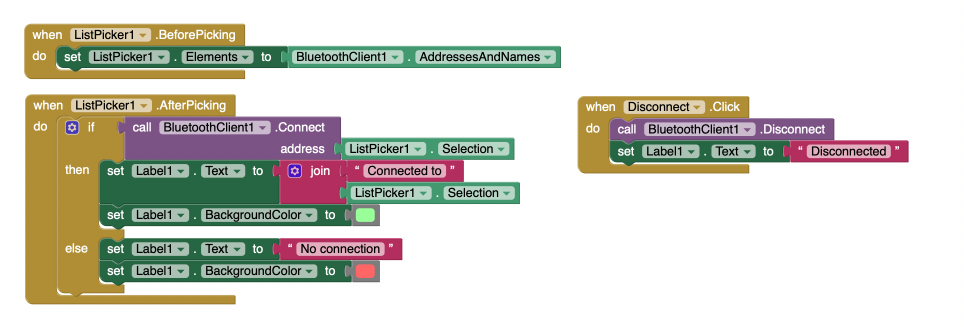
Testing and Downloading
MIT App inventor projects can be accessed for testing on the MIT AI companion app or built into a downloadable APK file. It can also be exported as a file to be later imported. The file extension for an app inventor project is “.aia”.
Conclusion
<Organized summary of the project>
<What did you learn?>
Project Video
Project Source Code
Advise for Future Students
<Bullet points and discussion>
Acknowledgement
=== References ===
